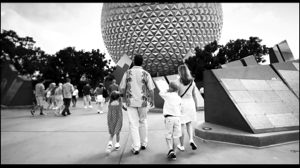Those are some mighty big balls you've got. Like, cartoonishly big. You're the one who ultimately told writer/director Randy Moore, sure, go ahead; risk a lawsuit from Disney - one of the most fiercely protected corporate identities in American history.
But you didn't stop there.
The official website for Escape From Tomorrow is throwing up a big middle finger at the notoriously litigious enterprise, featuring a big countdown clock titled "number of hours since release that we haven't been sued" (4 days, 13 hours, 41 minutes as of this posting). It's a dangerous game of chicken being played, but also a little transparent. You're obviously hoping a cease-and-desist order will allow you to market this as "the film Disney doesn't want you to see!". Except it's more likely to be the film Disney doesn't care if you see, because it's just not that good.
Still, the audacity of secretly filming an entire feature film at both Disneyland and Disney World is no small feat. And for much of what unfolds on screen, I'm not really surprised the crew got away with making this hand-held, black and white film. After all, it's simply the story of a man, his wife, and their two kids who are spending a day at the most magical place on earth as they endure spinning Tea Cups, long line-ups, and typical group separation anxieties. Shot with a few handheld 5D Mark II cameras, staging these scenes amongst the crowds wouldn't have phased a soul.
It's probably not even that uncommon for middle-aged men to navigate the whole park chasing young Lolitas who laugh and lick their lollipops in short-shorts as they frolic through the grounds. That's of course where the father (Roy Abramsohn) starts getting into trouble, before his mind starts to warp with surreal visions while on classic park rides like It's A Small World (that notably do not contain the most iconic, and lawsuit-worthy, characters).
There's a fine line being walked at times, but it's strange where you advised your client to take precautions. Epcot Center is frequently named and featured, becoming a center point of the film's climax, and images of the Disney castle and name of the park are used early on. But as the film dips into a more twisted (and strangely less interesting) tale, the word "Disney" is spoken but bleeped out, Walter Disney is referred to simply as "WD", and a bottle of lotion is black-bar censored (I'm still trying to figure that one out). How and why these things all come together, both at a narrative and legal level, feel circumstantial, and don't evidence a deeper or more meaningful film. This is a novelty product that's more shameless than anything Disney itself has ever done. Including Planes.
How's that for an indictment?
Sincerely,

Christopher







